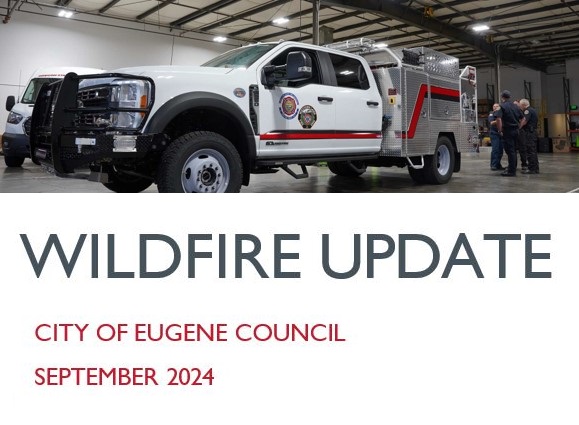Fire department leaders share Oregon wildfire update
4 min read
With a quick update on the Oregon wildfire season, on Sept. 11:
Eugene Springfield Fire Deputy Chief Chris Heppel: With that quick wildfire update: We are certainly all busy this year. We’ve actually been really busy this year, so we’ll take a look into what that is; what’s going on around the state and has been going on this summer and what we can expect for maybe the rest of the summer moving forward.
[00:00:24] In terms of large fires in Oregon, this year we’ve had 83. A large fire is defined as wildfires with timber that are greater than 100 acres, and in our grass or rangelands, mostly over here on the east side, more than 300 acres, or we have an Incident Management Team assigned to that.
[00:00:42] This year we’ve had almost 10,000 homes that have been threatened by wildfire. Disappointingly, we’ve lost 49 and we’ve lost 124 other buildings. So that might be like the pumphouse, the barn, some type of other outhouse, etc.
[00:00:57] This year we’ve lost, unfortunately, almost two million acres this year have been susceptible to wildfire.
[00:01:06] As a department, up until Sept. 6 of this year, we’ve been on a total of eight of the eight conflagrations. We’ve deployed 19 personnel. Our total hours of deployment have been about 2,600, we’ll probably with this fire be closer to 3,000, with some associated backfill hours.
[00:01:24] We’ll probably be just over 2,000 hours, apparatus hours, with an estimated reimbursement that’s probably going to be closer to half a million dollars that we expect reimbursementwise through the State Fire Marshal’s Office for us providing services.
[00:01:36] We’ve got our squads, which is a smaller apparatus that we will swing to and utilize especially during poor weather events, as you can imagine, getting around in the South Hills, in ice and snow, as an example, can be very difficult.
[00:01:48] We also use them for major events. We saw the first deployment of this during the World Athletic Championships. This unit became a good resource for us because it’s small, can get in and out of areas. It’s also very utilitarian. Not only does it take care of medical components, but it also has a fire component.
[00:02:04] We can use them in this space, out on a wildfire in Eastern Oregon; we can use them in wet poor weather events; we can use them at Duck games; we can use them whatever, so…
[00:02:13] Looking at fire across the landscape, we do have quite a few of them still going on out there. Just some quick facts. On average, we see about 400,000 acres a year that are lost. Remember I said, we’re going to be at about two million (acres) probably by the end of this year. That’s five years of loss this year. That’s what we expect right now.
[00:02:31] Some factors contributing to that, certainly global warming, challenges with overgrowth in our forests, drought and insect infestation which weaken and kill trees has been a huge part of it. We’ve also experienced three major lightning storms, which is unusual for us. We do get some onesie-twosies here, but those have been significant with a lot of starts.
[00:02:51] Weatherwise, we’re also seeing the transition from El Niño to La Niña this year, which really starts to change up some of our winds and we’re starting to see more of those east winds starting to come around, which is what precipitated the 2020 fires a few years ago.
[00:03:07] What you can expect going into the future: Fires are going to continue to be large like this, and you can expect them to be moving west and north. And that’s what we’ve seen is the precipitation of fires and large fires moving in that direction. So that’s what we expect going into the future.
[00:03:22] With that future, we were successful in obtaining one of these (Type 6) units from the Oregon State fire marshal as part of their engine program, and we will be receiving this particular unit, which will go into service when the chief lets us know (probably later on this year), but this is a great resource that we will be able to utilize in our local community to keep fires small and get on them quick.
[00:03:43] We also have been fortunate in that we’ve received some funding last year and the year before around some staffing funds, so, ensure that we have some folks staffed on those red flag days, additional units staffed on the red flag days, etc., again, to get fires quick and keeping them small.
[00:03:59] Councilor Alan Zelenka: It’s just crazy, the number of acres that are burning this year. I mean, we haven’t directly been affected so much in terms of smoke, but 2 million acres, it’s just crazy. I mean, in Labor Day 2020, which everybody remembers distinctly, that was just over a million. So, you know, we’re double that.
[00:04:20] And if you don’t think climate change is real, this is really real. This is a direct result of climate change. It’s only going to get worse.
[00:04:31] Eugene Springfield Fire Chief Mike Caven: Chief Heppel is out on the Rail Ridge Fire in Eastern Oregon. He’s the Planning chief with one of his many deployments this summer, partially why I tapped him to brief you on just what’s going on in the state in a historic wildfire year and also recognizing and just to present to you a level of appreciation for his work and so I wanted to share that appreciation with him and his work around the state.
[00:04:54] John Q: The city hears a wildfire season update live from the Rail Ridge Fire.





